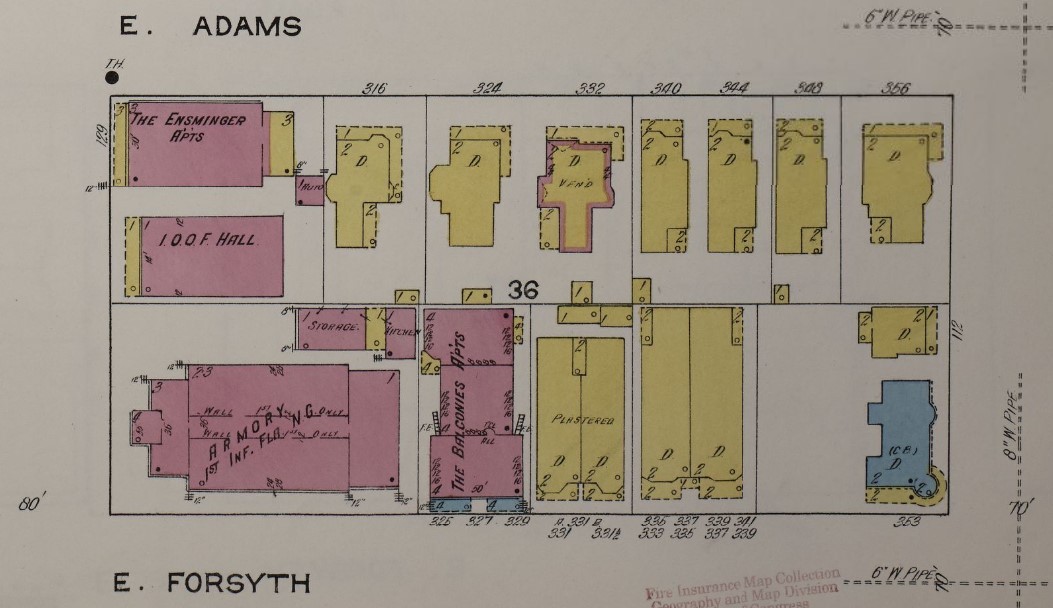In Jacksonville’s downtown is the Plaza Hotel, often called the Plaza Building, a historic hotel and residential building. Augustus Bexley’s former residence was located on the lot where the Plaza Hotel was built in 1903. During the Civil War, Bexley, a Lake City-born grocery and real estate agent, was the Confederacy’s chief surgeon. Bexley purchased the land before 1887 and constructed a brick home. It was enlarged between 1891 and 1893 by adding a huge veranda and a three-story tower on the southwest corner of the house.
Bexley lost his house in the Great Fire of 1901, along with most of the other homes in downtown Jacksonville. In May 1903, Bexley’s son Robert Risby Bexley received a building permission to reassemble the home as a hotel. To build the new structure, William F. Ivers, a local builder and former Jacksonville chief of police, was brought in. Except for the tower’s placement on the southeast corner of the structure, it was intended to imitate the earlier house that was destroyed in the fire. December 1904 saw the completion of construction.

Historical Importance
Fireproof prefabricated concrete blocks, a relatively new building material that was originally produced in Jacksonville in the late 1890s, were used to construct the Plaza Hotel. As early as the 1870s, concrete blocks were used in Tampa, Florida, for construction purposes. At first, using this material was thought to be a good alternative to fine stone, which was pricey because it wasn’t native to Florida. Jacksonville doesn’t currently have any concrete block structures that date back to before the Plaza Hotel. Prior to the Plaza, only one building has been officially recorded as being constructed out of concrete blocks: the former Duval County Armory, which was rebuilt in 1916 after being completely destroyed in the Great Fire of 1901.

Historical Importance of 1913 Jacksonville, Florida, Sanborn Fire Insurance Map. The Plaza Hotel is shown in blue at the bottom right. On the west side of the block is the location of the former Duval County Armory. Congress Library
In order to capitalize on the impending tourist season, it opened in early 1905. Pamphlets and brochures promoting the hotel described it as “a handsome stone building one block from the fashionable Bay Street district and two blocks from the Clyde New England Pier.” It is intended for sophisticated visitors and is located in the aristocratic area. The Plaza was a great place for overnight guests because of its proximity to the Duval County Courthouse and the steamship pier.
In the late nineteenth century, Jacksonville, a seaport and railroad town, saw a flourishing tourism industry. For both short-term and long-term visitors, the city had hundreds of hotels and rooming houses. But the majority of the lodgings for tourists were destroyed in the 1901 fire. Few of these abandoned tourist hotels were not restored as Jacksonville had lost a significant portion of its tourism business to Southeast Florida’s more well-liked travel spots by the early 1900s. In Jacksonville’s downtown, The Plaza is the oldest historic hotel still standing.
In the latter part of the 1800s, Jacksonville, a seaport and railroad town, saw a boom in tourism. The city offered both short-term and long-term visitors hundreds of hotels and rooming houses. However, the majority of those vacation rentals were destroyed in the 1901 fire. Few of these lost tourist lodgings were not replaced because, by the early 1900s, Jacksonville had lost a large portion of its tourism business to Southeast Florida’s more well-liked travel spots. The Plaza is Jacksonville’s downtown historic hotel, the oldest of its kind still standing.
Before Robert Bexley and his family started utilizing the Plaza as a residence in 1913, it was run as a hotel. In its subsequent history, Bexley and his descendants, Sarah Ellis and Mary Connery, lived in the house, which was also occasionally used as a boarding house. Local lawyer Glenn K. Allen acquired the property in 1985 and made renovations to turn it into a legal office. The U.S. National Register of Historic Places received its addition on December 30, 1992. Oxford Ink Tattoo is presently the building’s occupant.


